How to choose an infrared heater: classification, tips and popular models
Interest around heating rooms with infrared devices does not subside: some consider them ineffective, others consider them the most comfortable and economical.
Before choosing an infrared heater, you need to understand its technical characteristics and installation nuances, as well as get acquainted with the modern models on the market. It is these issues that our article is devoted to - here we will take a detailed look at the advantages of this type of heaters and highlight the main varieties present on the market.
We will also consider the best models from well-known manufacturers, which users rated higher than others. In addition, the article is equipped with thematic photos and videos with recommendations for choosing the best heater for your home and apartment.
The content of the article:
What are the benefits of IR heaters?
Unlike radiators and convectors, infrared devices have a completely different principle of operation. They initially heat not the air space with which they come into contact, but objects exposed to infrared rays.
If there is a cabinet in the room opposite the heater, then the vertically located surfaces of this cabinet will heat up first, and only then the air.
Why do users abandon traditional devices and purchase infrared devices?
According to reviews, IR devices for household use have a number of undeniable advantages:
- absence of a “heat zone” under the ceiling, characteristic of rooms with convective heating, since the heated air is evenly distributed throughout the room;
- possibility of local heating of a separate area, for example, a sofa in the living room or a dining table in the kitchen;
- safety for furniture and other objects that are “in the path” of IR rays;
- solving special problems – suppose, heating of glazed structures (windows, doors, double-glazed windows in the loggia), which in winter are cooled and reduce the air temperature in the kitchen, living room or bedroom.
IR heaters on the market do not require additional maintenance and are easy to operate. To operate the device, you must use the manual switch.
There are many more expensive automatic models available. If you install thermostat, then the heater will turn on or change the heating intensity if an increase/decrease in the temperature in the room is required.
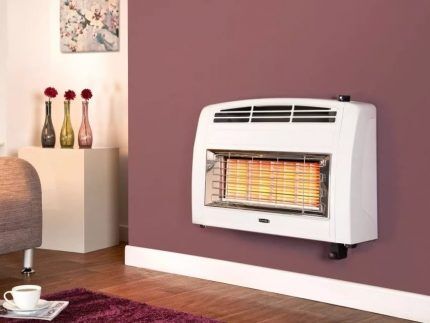
They also note the safety and environmental friendliness of the devices: during operation they do not emit substances hazardous to living beings and plants, and when installed correctly, the radiation itself has only a positive effect.
The disadvantages include the high cost of models with additional functions, the dependence of the heaters on installation errors and the poor health of some users. We talked in more detail about the dangers of IR devices In this article.
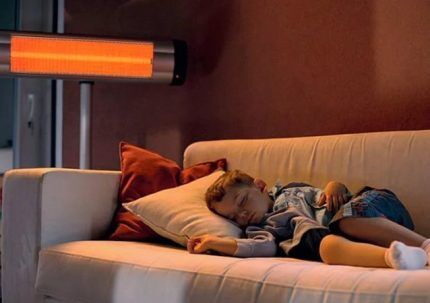
Classifications of infrared devices
The division into groups was based on such parameters as the length of thermal waves, location and method of installation, power supply (the energy source from which IR devices operate). Before deciding which model of infrared heater to choose, you need to get acquainted with all the possible options for devices.
Classification #1 - division by energy source
Depending on what kind of power the IR device needs, the following types of heaters are produced:
- electrical;
- gas;
- liquid (water);
- diesel (kerosene).
They differ not only in their energy source, but also in their design, characteristics and cost.
The largest group consists of electric models. They can be divided into two subgroups: emitting thermal waves and emitting heat + light.
The second subgroup includes devices with halogen, carbon or quartz lamps, the main heating element of which can be a carbon spiral, tungsten or nichrome filament.
There is also a classification according to the type of heating element, when lamp devices are classified into one group, solid-state (ceramic) devices into another, and film to the third. Some manufacturers classify devices based on the characteristics of the model range.
For example, a series of devices from the Ballu brand (S2, AP4, APL, LW, etc.) are arranged depending on the installation location and specific purpose - heating an entire room, an area on the street, or a separate item.
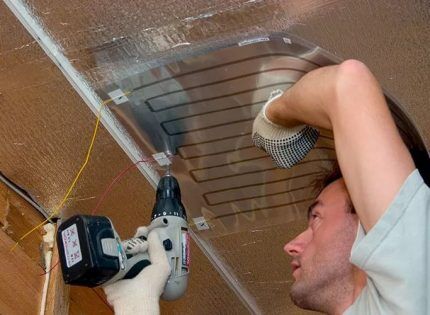
Gas devices were previously used only for heating industrial facilities, but now many household models have appeared. They operate from gas cylinders of various volumes (usually from 5 liters to 50 liters) and consume approximately 300-350 g of fuel per hour.
Safety is achieved by safety valves that are activated if the gas supply stops or when the CO concentration reaches2 in the air more than one and a half percent.
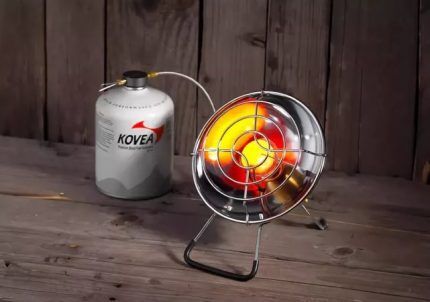
Diesel heaters are used where it is not possible to connect to electricity or use a gas cylinder. Mobile models can also be taken with you to the dacha or garage.
There are special camping options for tents. They are efficient and economical as they require little fuel.
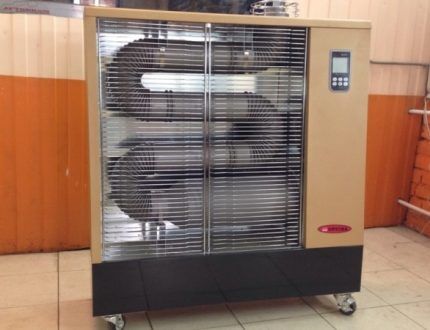
There is also such a variety as infrared electrical appliances with hot water supply. They are connected to the heating system and provide heating to the lower part of the premises. An example is the FRICO Aquaztrip AZB panels, created specifically to save energy consumption in industrial and administrative buildings.
A striking example of a floor-mounted electric IR heater, ideal for local heating of an office or home, is Scarlett SC-253.
The cost of Scarlett SC-253 at various points of sale is from 2400 to 2700 rubles, that is, it can be classified as a budget model.
Classification #2 - difference in installation method
According to the type of installation, all devices can be divided into 2 categories:
- stationary (ceiling, hanging, plinth, wall-mounted);
- mobile (indoor and outdoor).
The first type is suitable for users who regularly need to heat the room as a whole or a separate area. The shape and dimensions of the devices depend entirely on the installation location. For example, ceiling models most often have an elongated configuration, while wall models are rectangular or square.
In addition to conventional wall-mounted heaters, there are also built-in heaters that can be placed in a suspended ceiling or shelf.
Floor-standing models are usually equipped with stands or legs, some of them have a handle for easy transfer to another location. Mobile modifications are smaller in size, although there are exceptions, and lighter in weight - everything is provided for easy transportation. They also do not have much power, but are quite suitable for local heating.
Popular models by installation location:
Heaters designed to heat limited areas on the street (open terrace) cannot be used in closed, and especially in residential premises. Modern models for outdoor use, like their indoor counterparts, are equipped with safety safety devices: they automatically turn off when the flame goes out.
Classification #3 - varieties by radiation range
Experienced users of infrared equipment are well aware that they can also differ in wavelength. The power of the device and some other technical nuances depend on this indicator.
Conventionally, there are three groups of IR heaters, differing in wavelength:
- with short waves;
- with averages;
- with long ones.
The first type of device can be recognized at the moment of switching on thanks to the wave range from 0.5 microns to 3.0 microns. The heating elements are halogen or carbon lamps, which produce bright radiation and can heat up to a temperature of +900 °C.

Medium wave devices heat up to approximately +550-600 °C and have waves with a length of 45-50 microns. A barely noticeable light is perceptible, but with difficulty. Long-wave models are devices intended for home use. They heat up to a maximum of +300°C in the range of over 50 microns, that is, the waves are practically invisible.
Recommendations for choosing a heating device
Before purchasing, you have to decide: which model of infrared heater is better to choose for your own use? If you are interested in the option of an infrared carbon device, we recommend that you familiarize yourself with the varieties and tips for choosing a carbon model.
It is also necessary to determine where exactly the device will be installed, whether it is necessary to transfer it to another room, what heating area should be calculated, which power source is preferable for it.
Power is calculated in the standard way: 1 kW per 10 m², that is, to heat one room you will need a device no more powerful than 2 kW.
One of the indicators of the “longevity” of home heaters is durable materials and good build quality. Sometimes you can even judge by eye how reliable and functional a thing is.
If there are no nicks, chips or scratches on the body, all parts fit exactly to size, the grille is not deformed, adjustment is free - the product is of decent quality.

Be careful with the cheapest models. Even if you are satisfied with the appearance, you need to look for a catch - perhaps it’s due to low-quality materials or the lack of any protection. Heater safety is one of the main criteria, for which you can overpay.
If the price is higher than usual, then the device is equipped with additional devices that may be useful. For example, a thermostat that controls the temperature, an overheat sensor or a remote control.
Read an article on the website about the most the best models of infrared heaters in 2022.
Review of popular models
When evaluating a particular model, users pay attention to the following nuances:
- design features;
- a set of additional options;
- installation method;
- price of the device;
- energy consumption;
- power, etc.
As a result, we selected the best models that combine high quality workmanship and positive performance characteristics.
Model #1 - DeLonghi HMP2000
A universal device that can be installed both on the floor and on a vertical surface. Special mounts are provided for wall mounting.
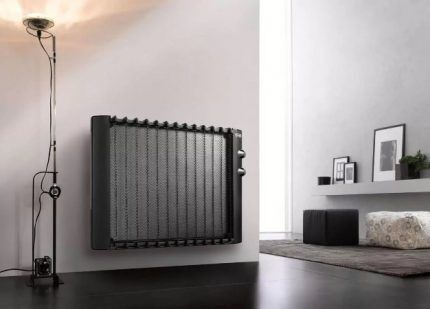
Floor-standing models are equipped with small wheels for moving around the apartment. Power adjustment is done mechanically using a handle located on the body. The cost of the heater is 4.5 thousand rubles.
Model #2 - Polaris PKSH 0608D
The two-mode carbon heater is convenient for home use. Power adjustment from 400 to 800 W allows you to set the device to a comfortable operating mode. It is possible to rotate the body, which is located vertically, by 70 degrees.
In case of accidental overturning, the automatic system is activated and cuts off the power supply. An electronic thermostat and remote control make the model even easier to operate. The cost of the device is 3,250 rubles.
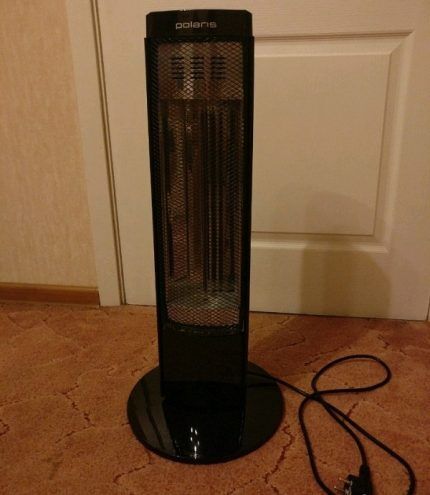
Model #3 – Teplophone ERG/EVNAP 1.0
The Teplofon Binar model effectively heats an area of up to 12 m² and has a power of 1 kW. The secret of its popularity lies in the dual principle of heating the room: it can carry out heating by convection and using an IR glass panel.

If desired, the wall-mounted device can be installed on the floor - there are special legs for this. The unusual design, glossy glass panel and convenient adjustment method made the model popular, despite the high cost - 6,300 rubles.
Model #4 – Ballu BIH-APL-0.6
The budget wall-mounted model has an affordable price - 2,500 rubles and a power of 600 W, which is enough to heat 6 m² of area. If you need to warm up a larger room, you should install several devices with the same interval between them.
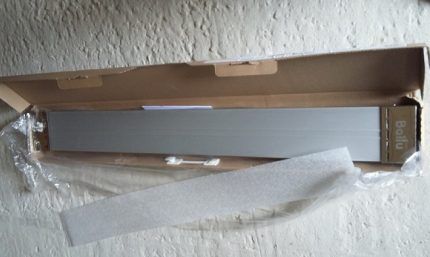
The heater comes with fasteners, which can also be used for wall installation if desired. Light weight, modest price and simple design have made the model popular for equipping office premises.
Manufacturers from different continents produce lines of high-quality infrared equipment, which differ in power and installation method. Among the famous brands are Hyundai, IRIT, Loriot, Neoclima, Rovex, Royal Clima, Scarlett, SUPRA, Timberk, Vitesse, Zencha, ZENET, Zilon.
If you like the principle of operation and efficiency of infrared devices, then you can use them to install infrared heating at home or assemble and connect heated floors.
We wrote more about these possibilities in the following articles:
- Infrared heating of a private home: a review of modern infrared heating systems
- Infrared film for heated floors: types of films, how it works, installation rules
- Infrared carbon heated floor: principle of operation and installation rules
Conclusions and useful video on the topic
To supplement your knowledge with additional information about IR devices and better understand their performance, we suggest watching useful videos.
The author of the following video argues in favor of purchasing an IR heater model:
Video recommendations for choosing the best heater for your home and apartment:
If among all types of heaters you still choose an infrared model, carefully study its characteristics. It would be useful to calculate the heat loss in the rooms and determine the power in advance. Find out whether the selected equipment can become a full-fledged heating device or will play the role of a backup/additional/local device.
Are you looking at IR devices when planning to buy a heater for your home? Maybe you still have questions after reading the article? Or want to tell other site visitors about your experience using an infrared heater? Write your questions and recommendations in the block under this article, express your opinion, share your experience with newcomers in this matter.




I can’t say for sure here, since I didn’t take any special measurements. However, it seems to me that after using just such heaters, the air turns out drier. This is only good if there was excess humidity. In this regard, oil radiators provide smoother heating and do not dry out the air. It is for this reason that they are more often used in apartments.
We used to use an oil convector and a fan heater. But because of these devices, there was a large overconsumption of electricity, and my throat was sore from dryness.
Last year we bought an electric infrared heater. We chose a portable one, on a leg, so that it could be moved from room to room and the height could be changed. We took it with a set of functions, a thermostat and a remote control. For us, it’s not just a substitute for heating, but it’s necessary to live in warmth and comfort while the central heating is turned on. And in severe frosts, supplement the heating as necessary.
This makes it much more economical to pay for electricity. Although the IR heater itself is, of course, more expensive than other types, it will pay for itself in a few years due to savings.
For a long time, a conventional electric heater worked for us, but it used up a lot of electricity. The fan heater broke down almost immediately after purchase. We looked for an alternative for a long time and eventually settled on an infrared heater. It heats the room well, and most importantly, it does not dry out the air. In general, I used to use a humidifier before, but now there is no need.